Almara
Analog Menstrual Cycle Tracker
Global Studio
Parsons, 2020, 4 months
Individual
Concept
Almara is an analog menstrual cycle tracker to educate young girls and women in sub-Saharan Africa of their menstrual cycle to lessen chance of possible conception and lower the maternal mortality rate.
How It Works
Each bead within the bracelet or anklet represents a day in the 28 day menstrual cycle.
The user moves the tassel
each day to represent where they are in their cycle.
The different bead types represent phases within the menstrual cycle:
1. Menstruation
2. Follicular phase/Fertile window
3. Ovulatory window
4. End of fertile window
3. Luteal phase4
Icons
To make Almara accessible and easy to understand, icons were used to teach women about their menstrual cycles and provide a schedule to help prevent unwanted pregnancies. The packaging was designed to be repurposed as a reference when hung on a wall.
How to Use
1. Locate the tassel
2. Unhook the tassel
3. Locate the next bead
4. Hook the tassel to the right of the bead
Problem
One of the World Health Organization's Sustainable Development Goals is to reduce the global maternal mortality ratio. In 2020, 70% of worldwide maternal mortality deaths were in sub-Saharan Africa.1 Causes of these maternal deaths are preventable, but go untreated due to lack of essential maternity care, access to quality healthcare, and family planning.2
Additionally, sub-Saharan Africa has one of the largest rates of adolescent pregnancies in the world, with approximately half of all births to teenage mothers.3 Inadequate sexual education has been identified as a major predictor of adolescent pregnancy in sub-Saharan Africa, with some unaware of how pregnancy occurs.3 Thus, in order to decrease the maternal mortality rate, sexual education and control of personal reproductive health need to be strengthened.
Brief
Design an accessible tool for girls and women in sub-Saharan Africa that provides sexual health education and helps monitor and manage their sexual health to reduce unplanned pregnancies.
Preliminary Research
The initial brief proposed to the studio was to design a product that would assist in reaching one or more of the United Nation's Sustainable Development Goals (SDGs) for 2030.
The third SDG, Good Health and Well-Being, aligns most with my ethos as a designer. The first goal target is to reduce the global maternal mortality ratio to less than 70 per 100,000 live births by 2030. I was interested in learning more about maternal mortality and, after learning that sub-Saharan Africa has the highest rate of maternal mortality, I did a deep dive into why it's so prevalent.5-9
My deep dive research focused on three main questions:
1. Why is the pregnancy rate so high in sub-Saharan Africa and why do so many pregnancies lead to maternal mortality?12-18
2. Why do these women and girls not get the help they need when pregnant and experiencing symptoms of maternal mortality?5
3. What are the symptoms related to maternal death causes and how can they be treated or avoided entirely?2,10,11,19-25
Below is a slide deck of a compilation of my research:
Below is an interactive wall showing my preliminary research and design thinking process:
Initial Ideation
Based on my research thus far, I began ideation based on possible opportunities for change.
As a health and wellness designer, my main beliefs when it comes to healthcare interventions are:
1. They should be accessible—most medical device solutions that incorporate technology are not accessible to a large portion of the population.
2. Both form and function need to be considered—a medical device can be functional, but if it's unattractive, it's less likely to be used/worn. A medical device is ultimately ineffective if the user chooses not to use it.
For this brief, the users are girls and young women in low-income countries. Thus, using advanced technology is unfeasible and aesthetics are highly important. Below are my initial ideas for solutions:
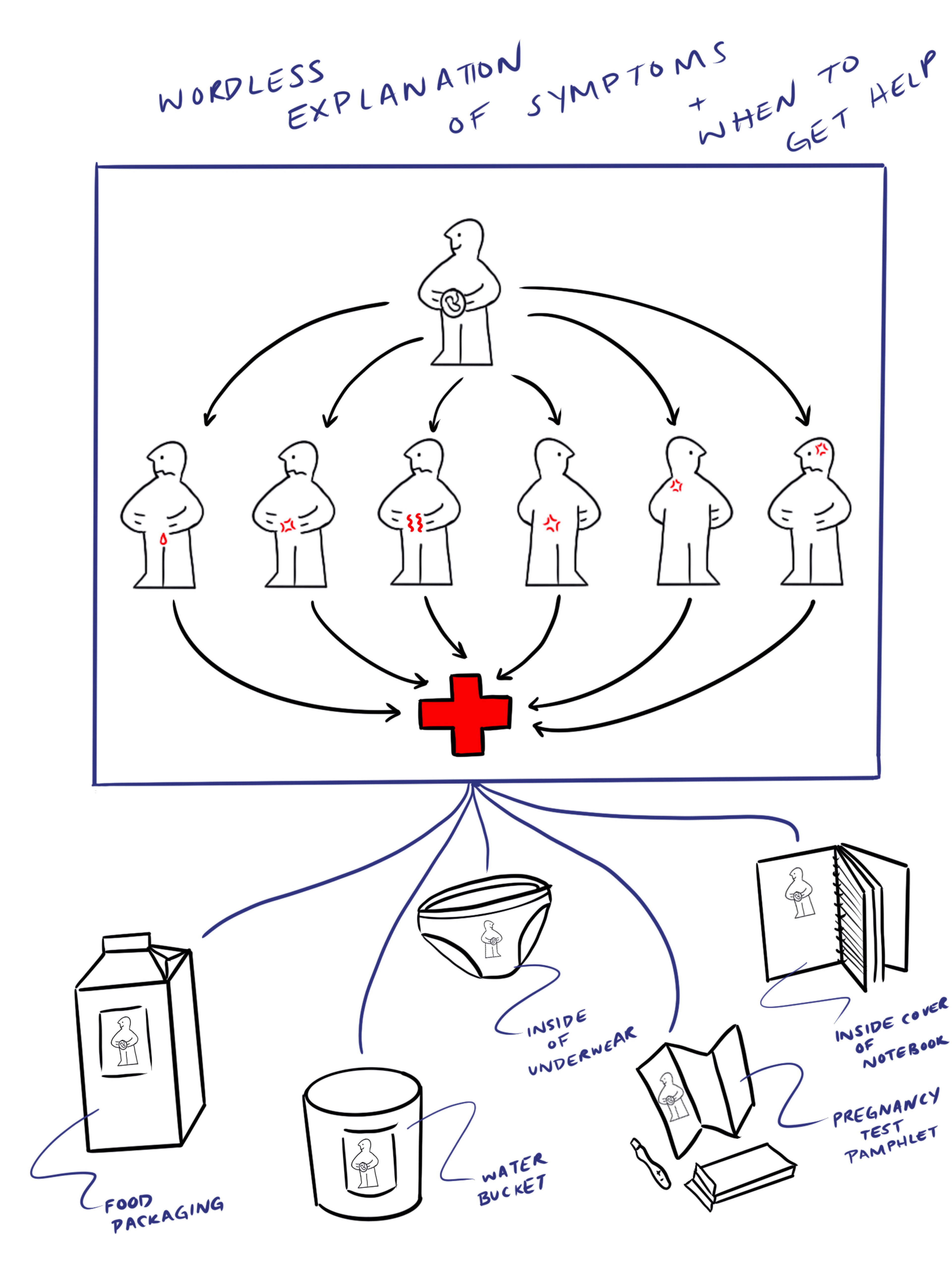
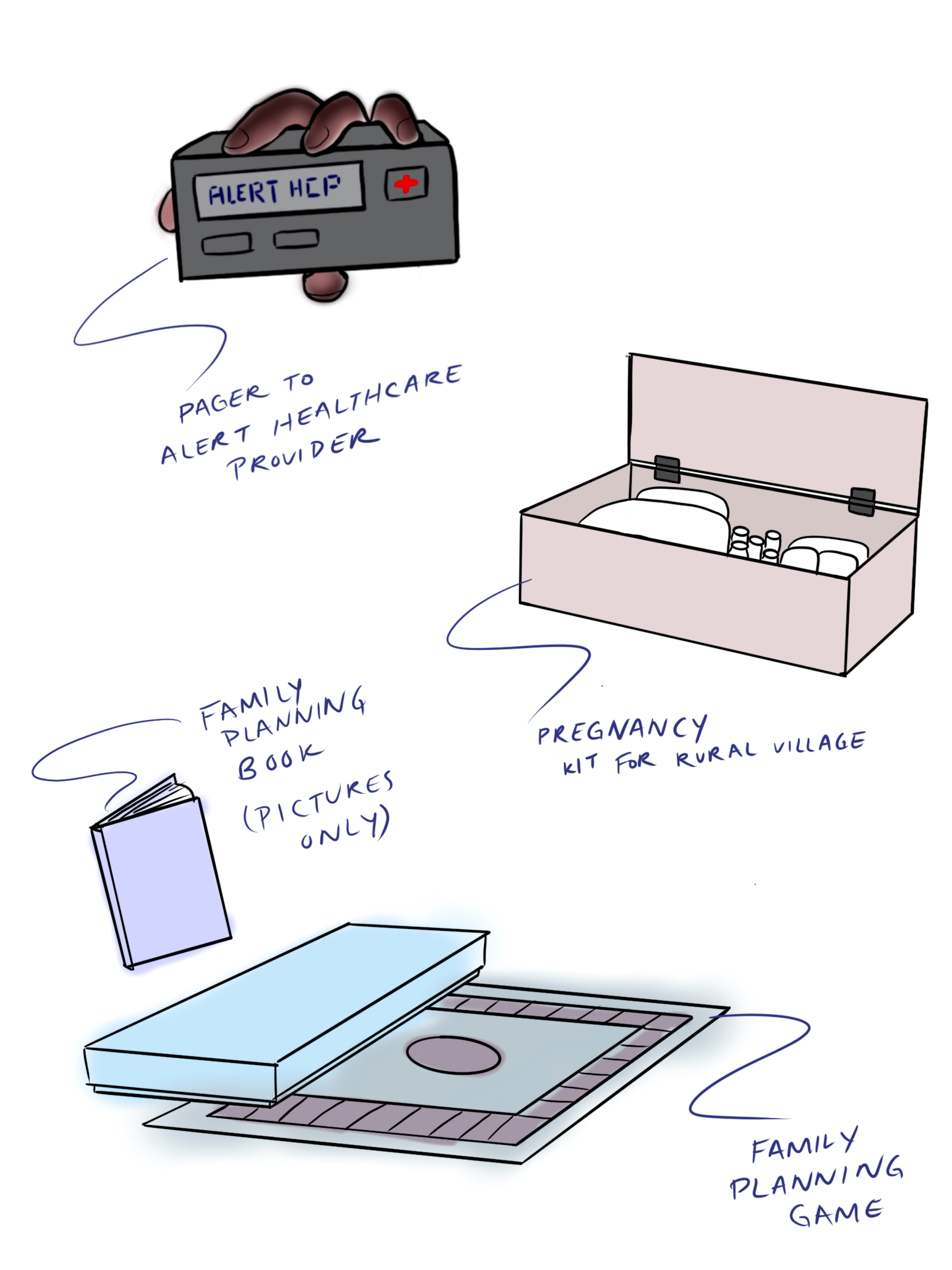
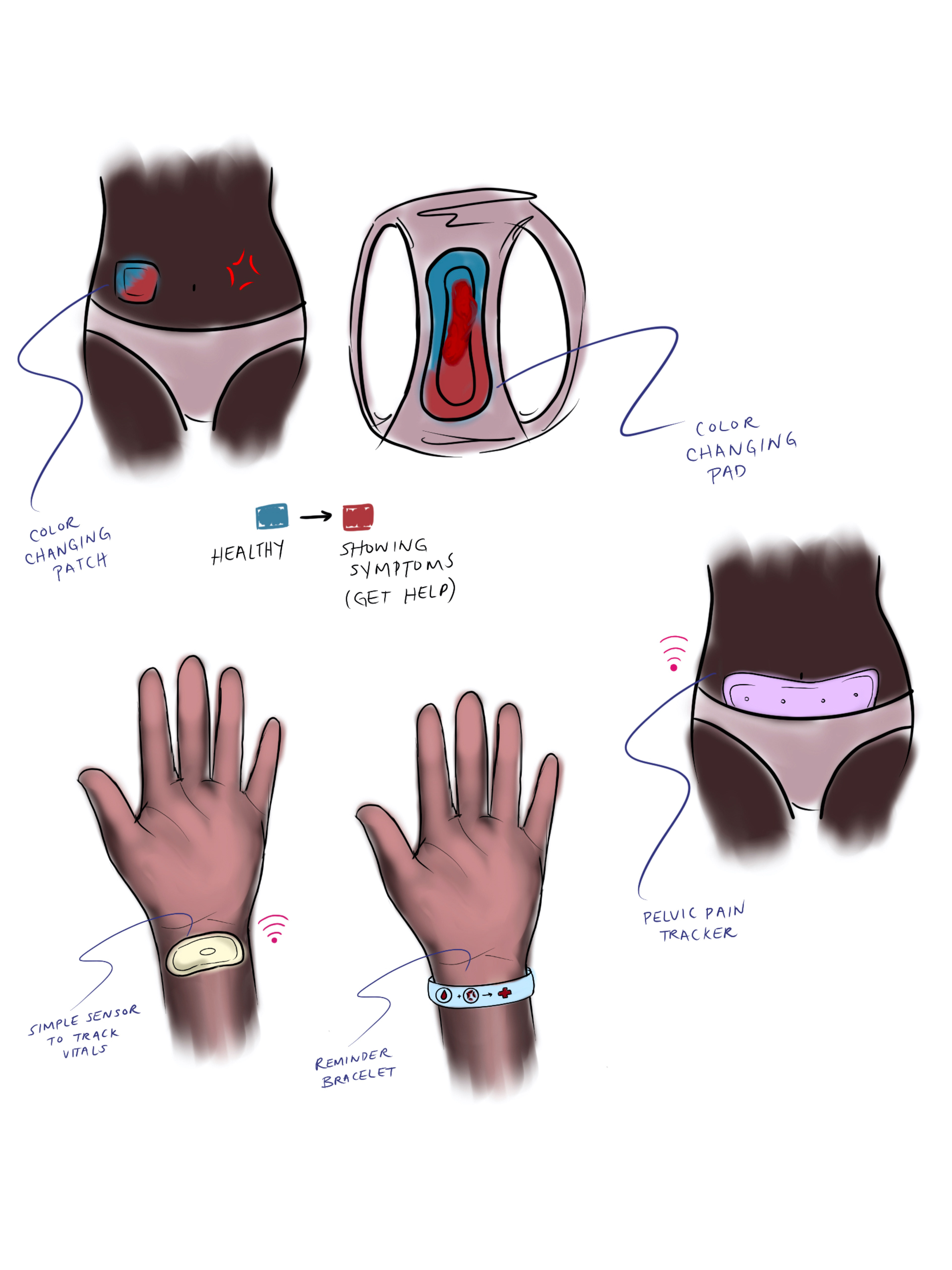
Interviews
For my initial research, I was able to interview two 26 year old women from Malawi, Faith and Shalia. I asked a series of questions relating to daily life of Malawi girls, including hygiene, health, education, and social interaction.
This is the information I gathered from the interview:
From the interview, I found the discussion we had about period tracking to be an area of intervention, focusing on a lack of education, community, and resources for menstrual cycle tracking:
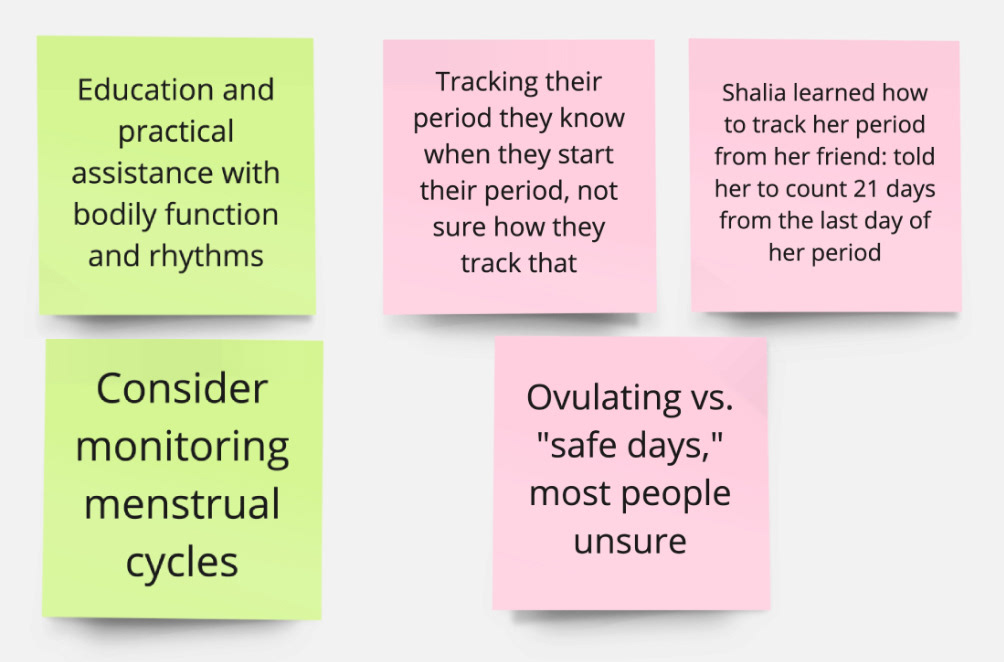
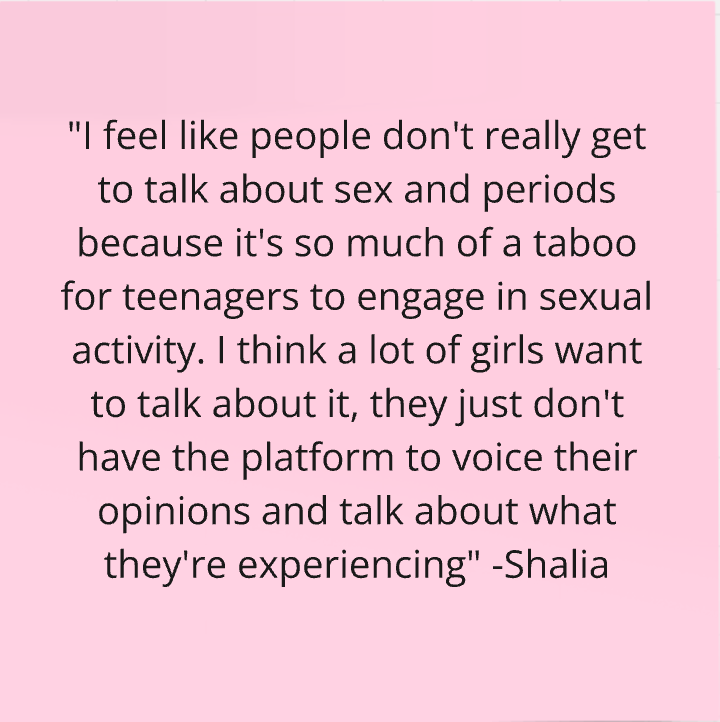
Market Research
I began conducting market research on menstrual cycle trackers and education that do not require a cell phone.
Be Girl is a mission-driven company devoted to providing menstrual products to adolescent girls. Their product SmartCycle is an analog menstrual cycle tracker accompanied by a menstrual guide and an educational course.
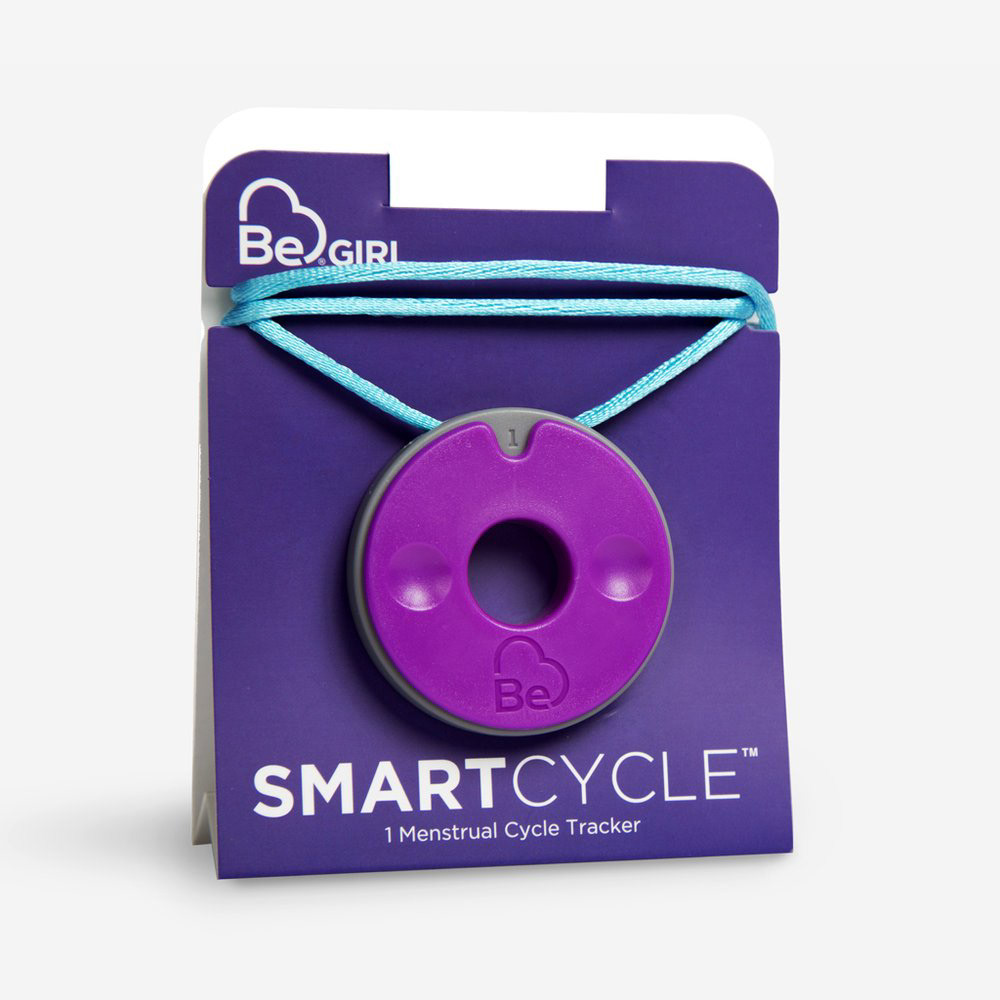
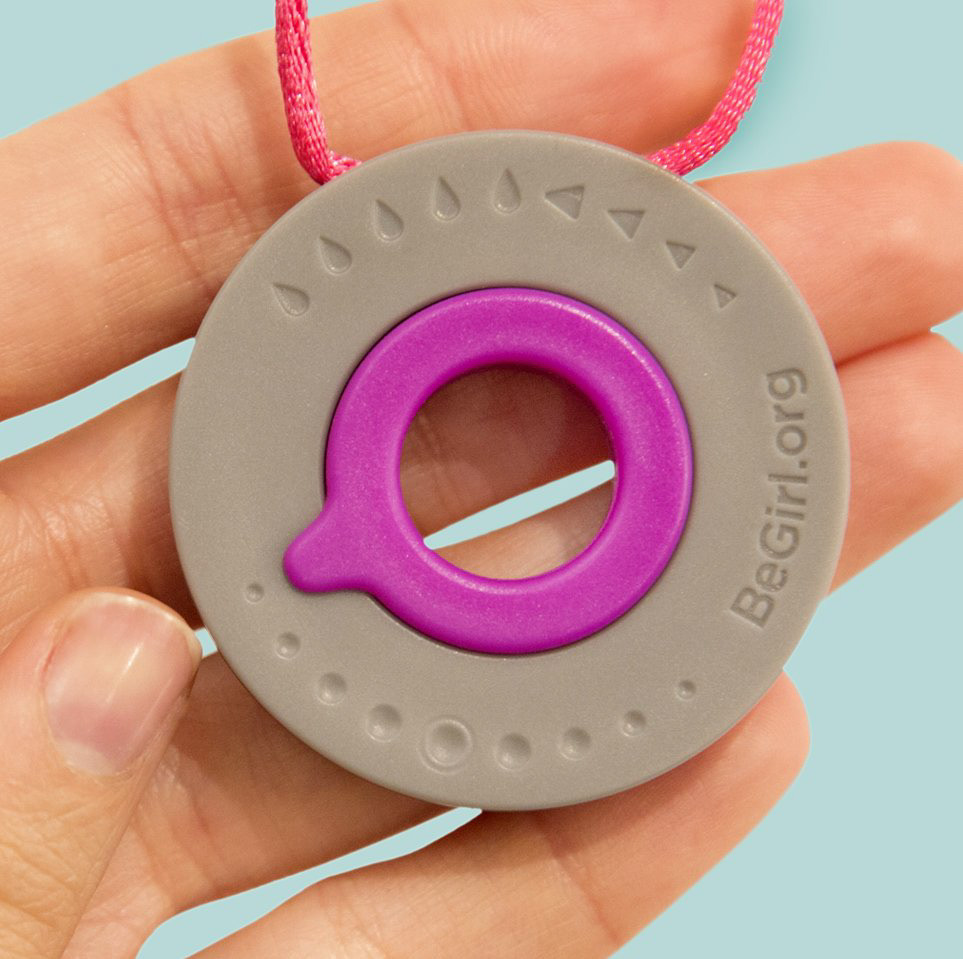
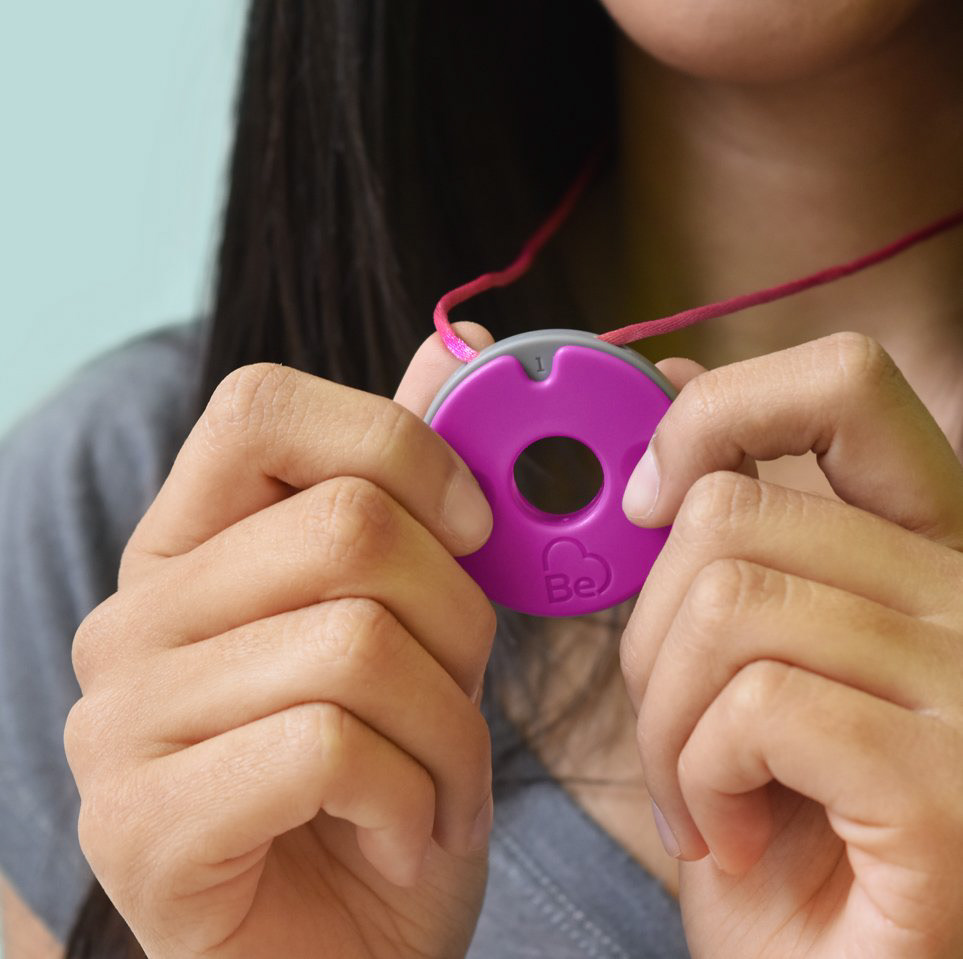
SmartCycle Packaging with Instructions
SmartCycle Menstrual Guide
Although SmartCycle's design is practical and conceptually simple to use, I do notice some issues with the products and spaces where I could intervene:
1. The packaging instructions and menstrual guide are fairly inaccessible, especially for low-income countries, where most have high rates of learning poverty and low reading comprehension.
2. The product itself is unattractive and does not appeal to the users' cultural fashion trends—the target user for their product is a young teenage girl and I do not see 14 year old girls wanting to wear this device every day.
Moving forward, the additional requirements of my design are:
1. The product and packaging need to be simple and fully accessible
2. The product should align with the user's cultural fashion trends to encourage wear
Ideation
Based on information gathered in my interviews with Faith and Shalia, I knew that an anklet would be a way to incorporate my tracking device in a popular wearable form. Using the cyclical form of the menstrual cycle as inspiration and as a guide, the design uses beads to represent days of the cycle with different colors or shapes indicating the different phases of the menstrual cycle.
What I needed to figure out was how to incorporate a moving piece and what that piece would be to indicate which day of the cycle the user is on.
Examples of Popular Jewelry in Malawi
I reached back out to Faith and Shalia for examples of popular jewelry amongst teens and young women in Malawi. I noticed a trend of beading, bright colors, and tassels in the examples they sent.
I wanted to reference these trends in the design, while also considering the possibility of the colors and shapes changing based on the location of the users.
Because tassels are so popular in Malawi, I decided to use a tassel charm as the moving piece of the design.

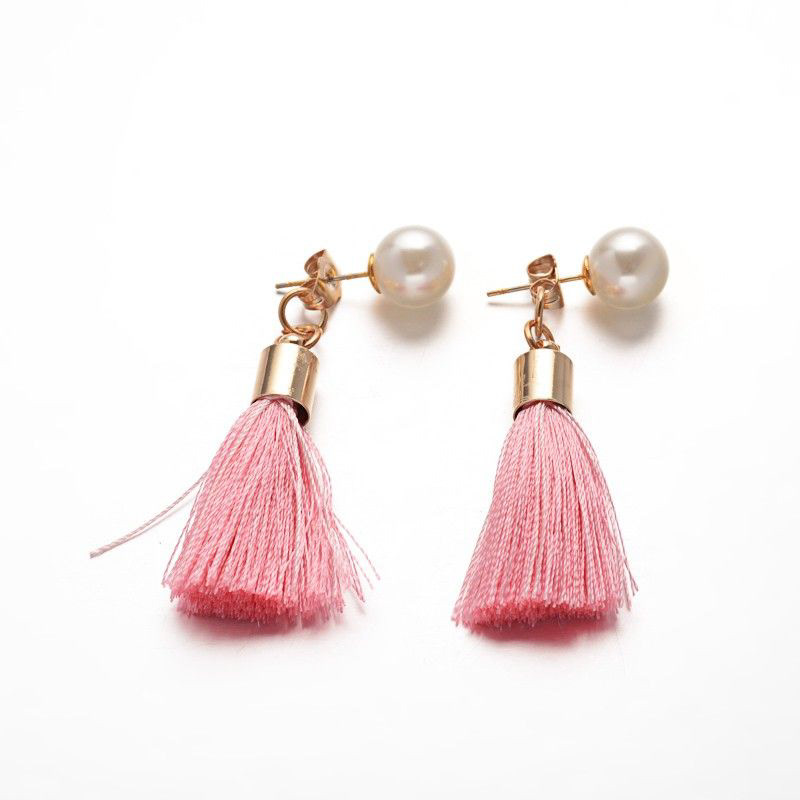
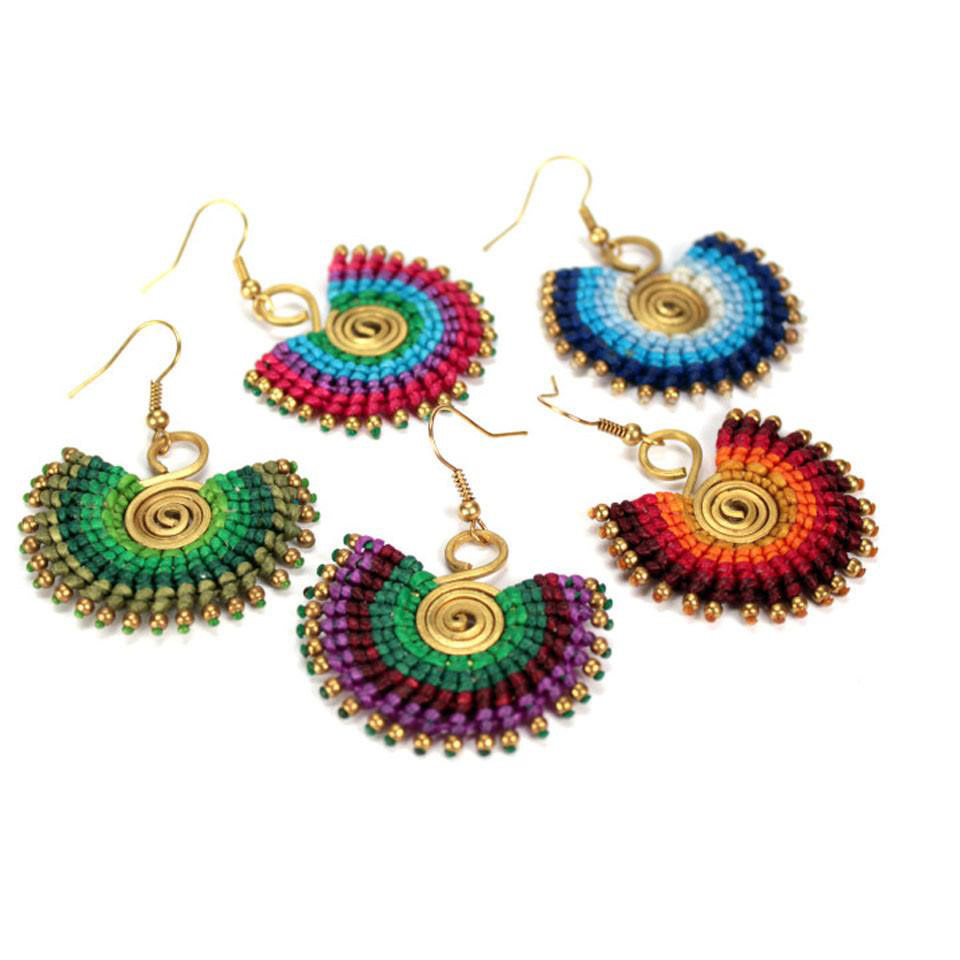
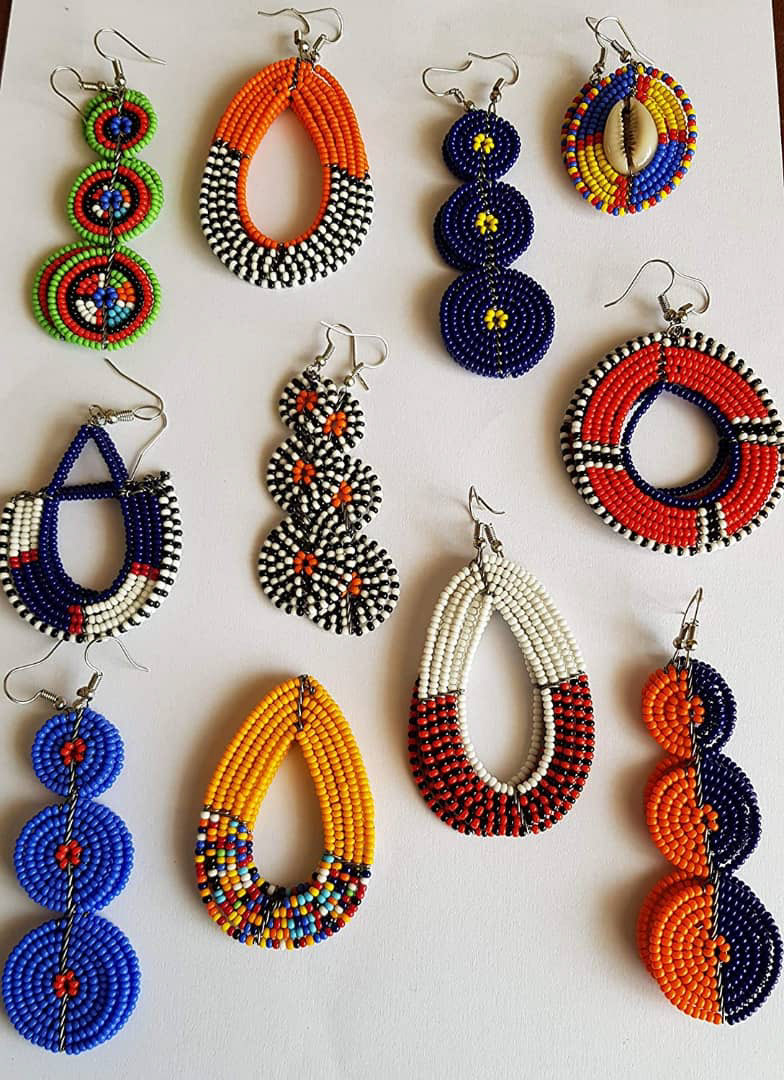
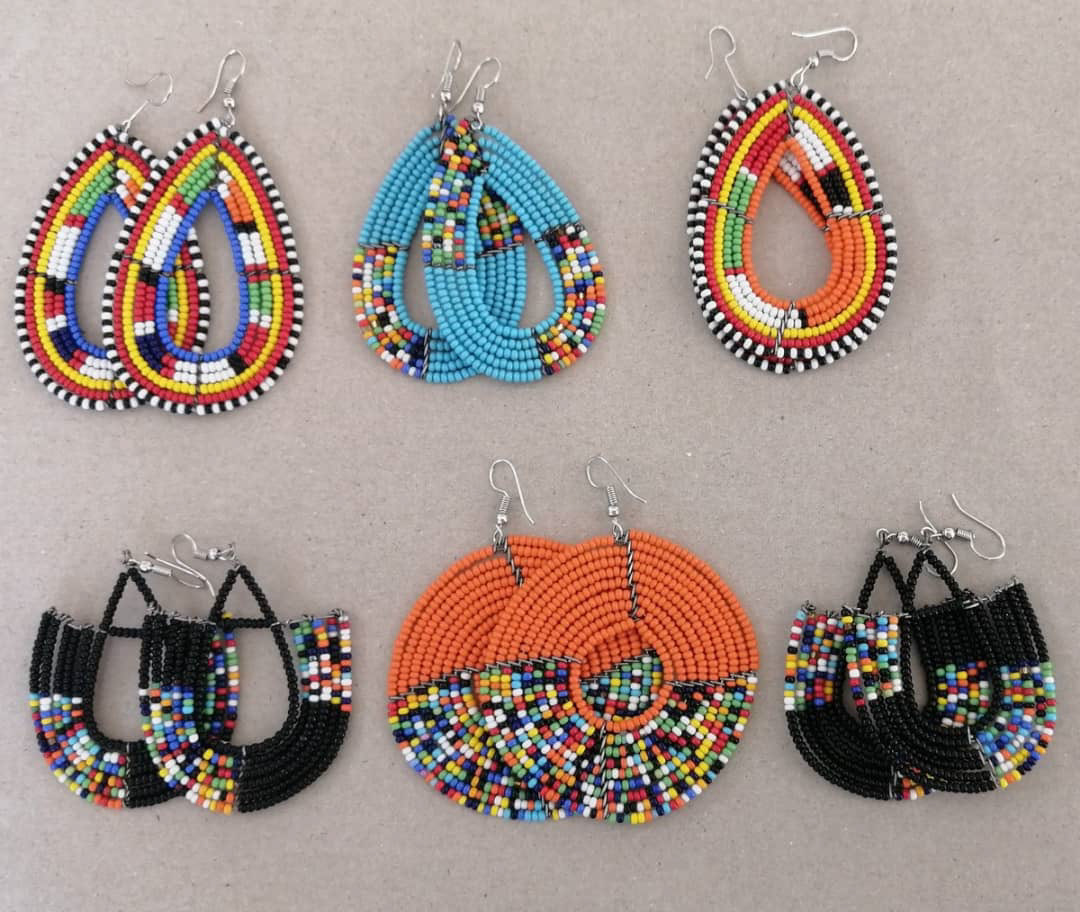
Western Trend Jewelry
I also referenced trending western beaded jewelry for alternating between bead shapes and sizes.
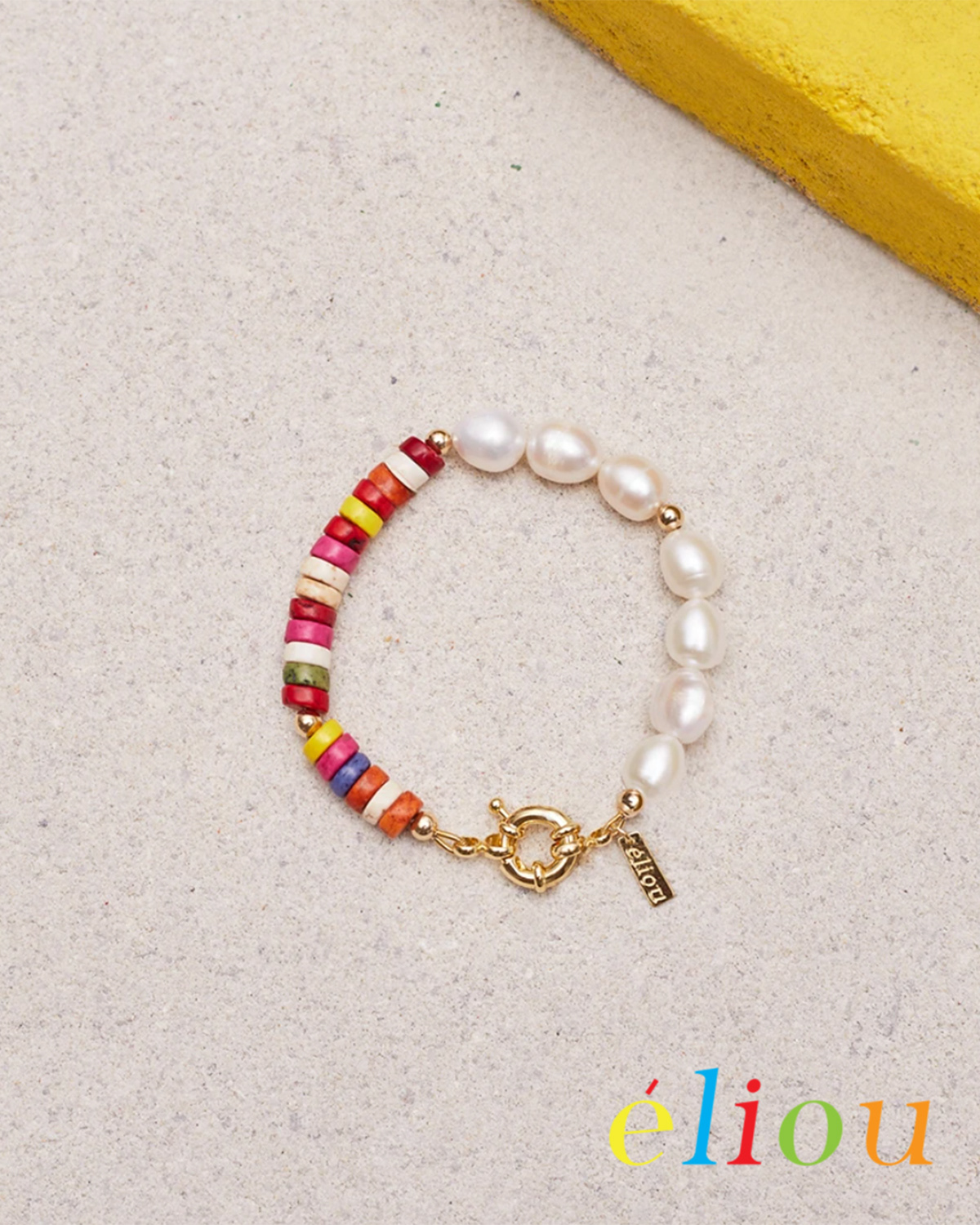
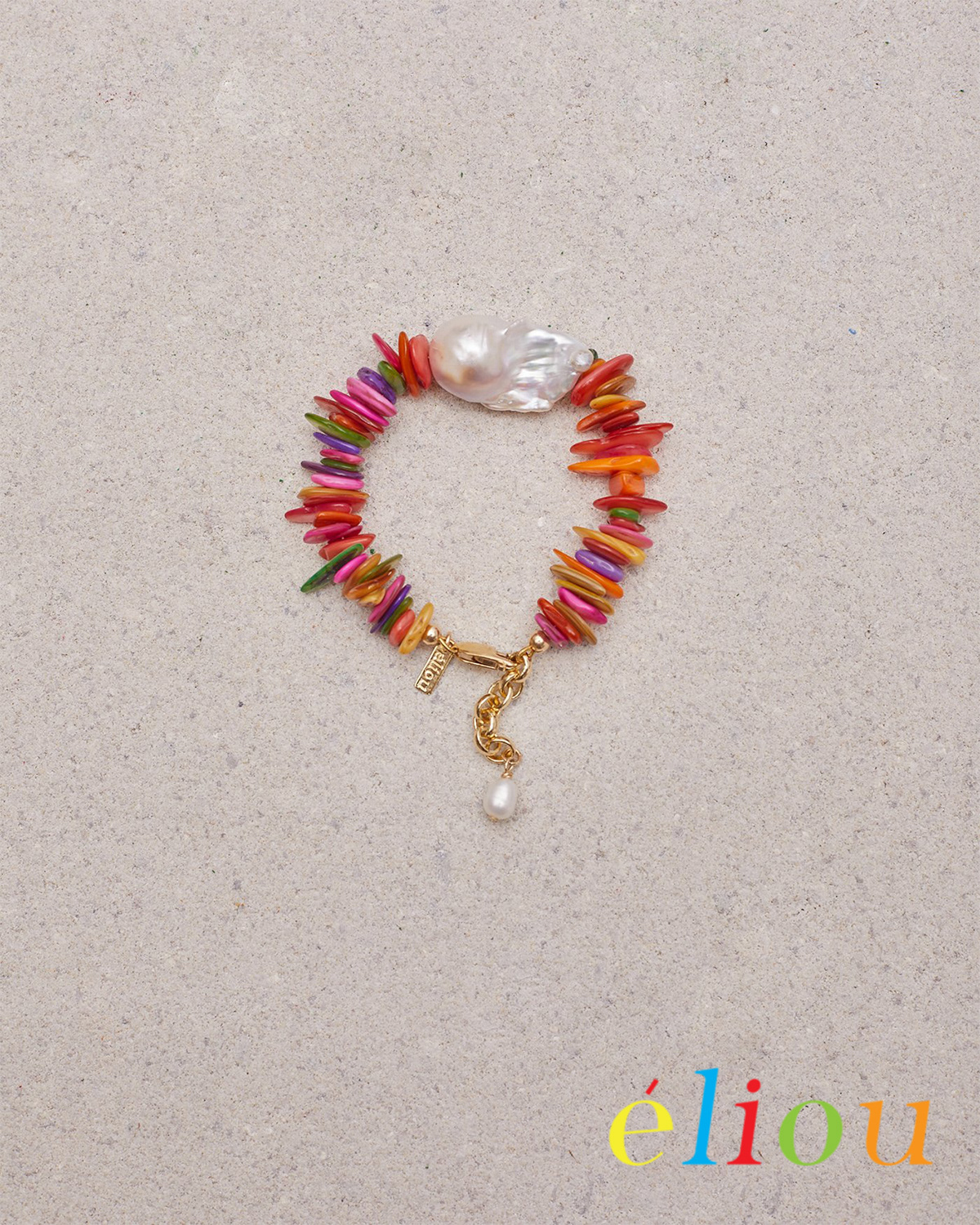
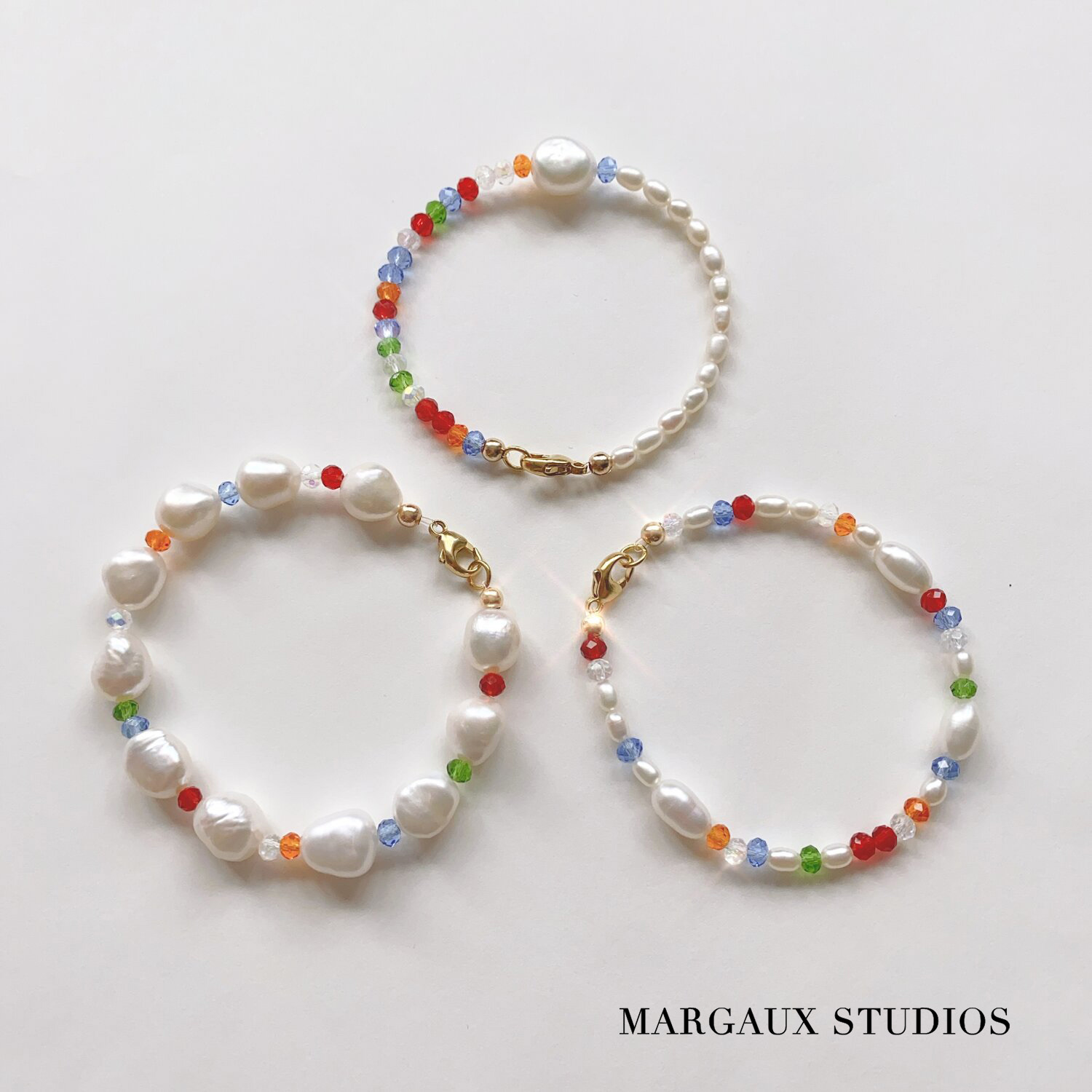
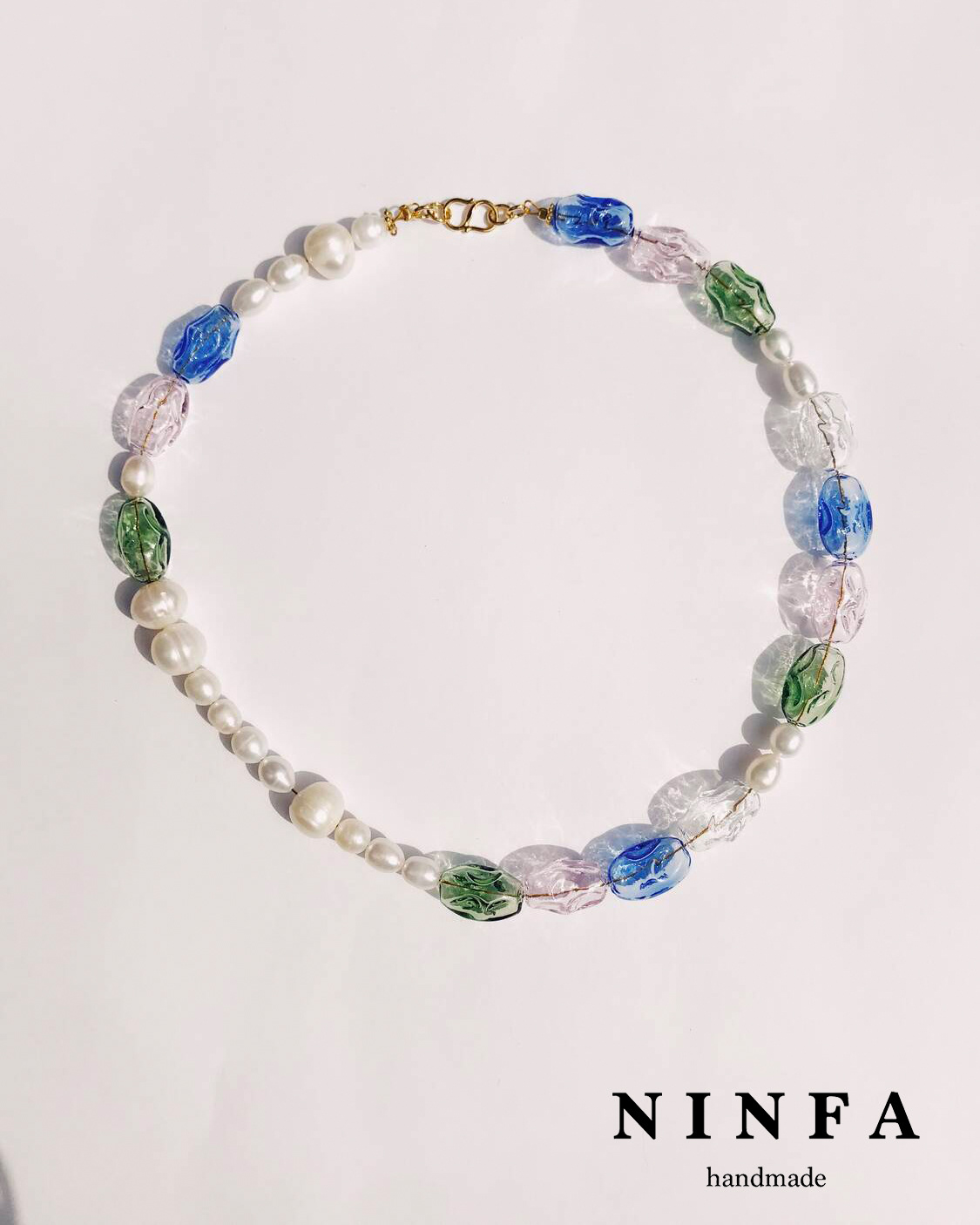
Material Selection and Prototyping
For material selection, I wanted to repurpose used beaded jewelry for sustainable purposes as well as a possible decrease in manufacturing costs.
I created multiple prototypes in various sizes and colors all referencing the menstrual cycle layout.
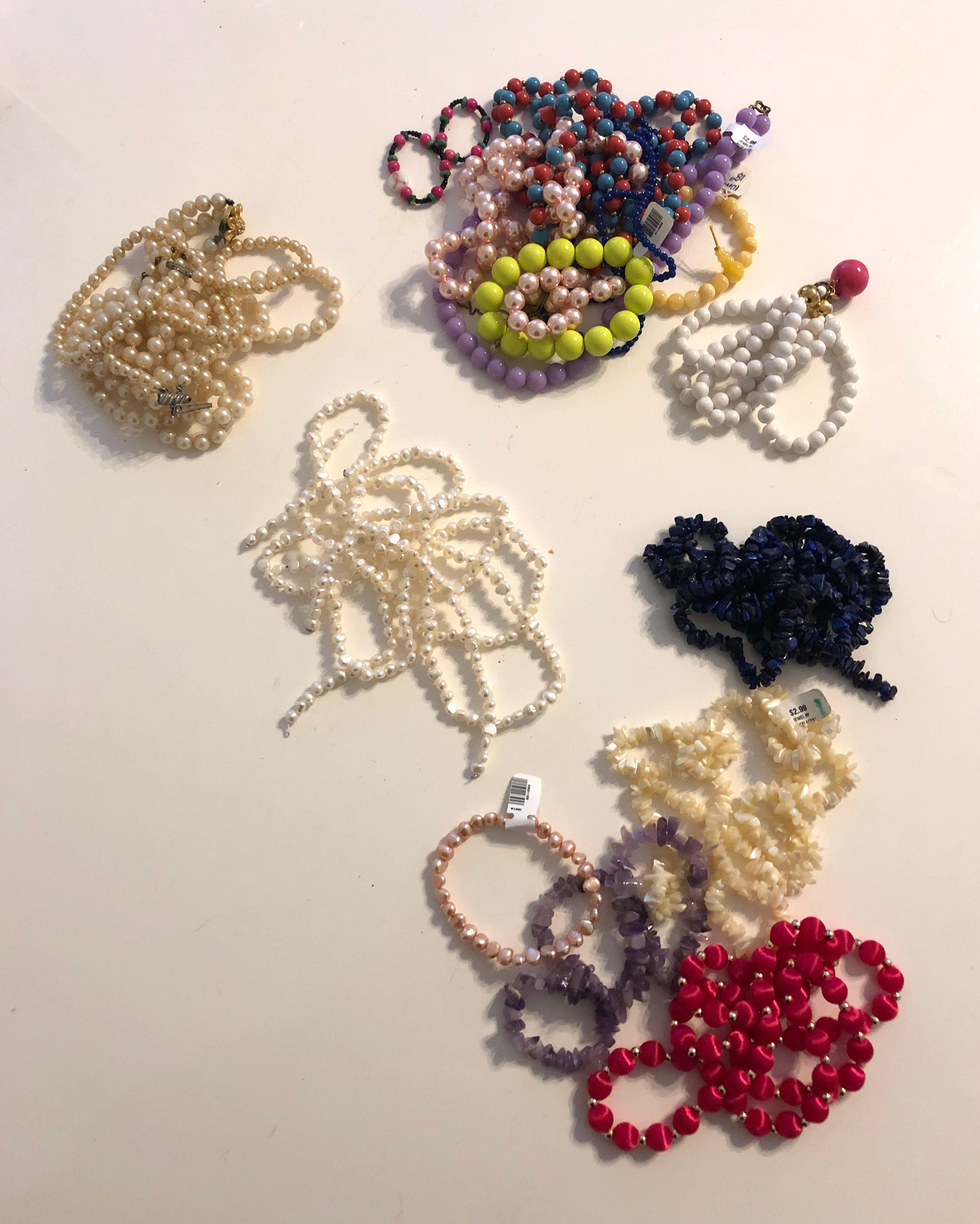
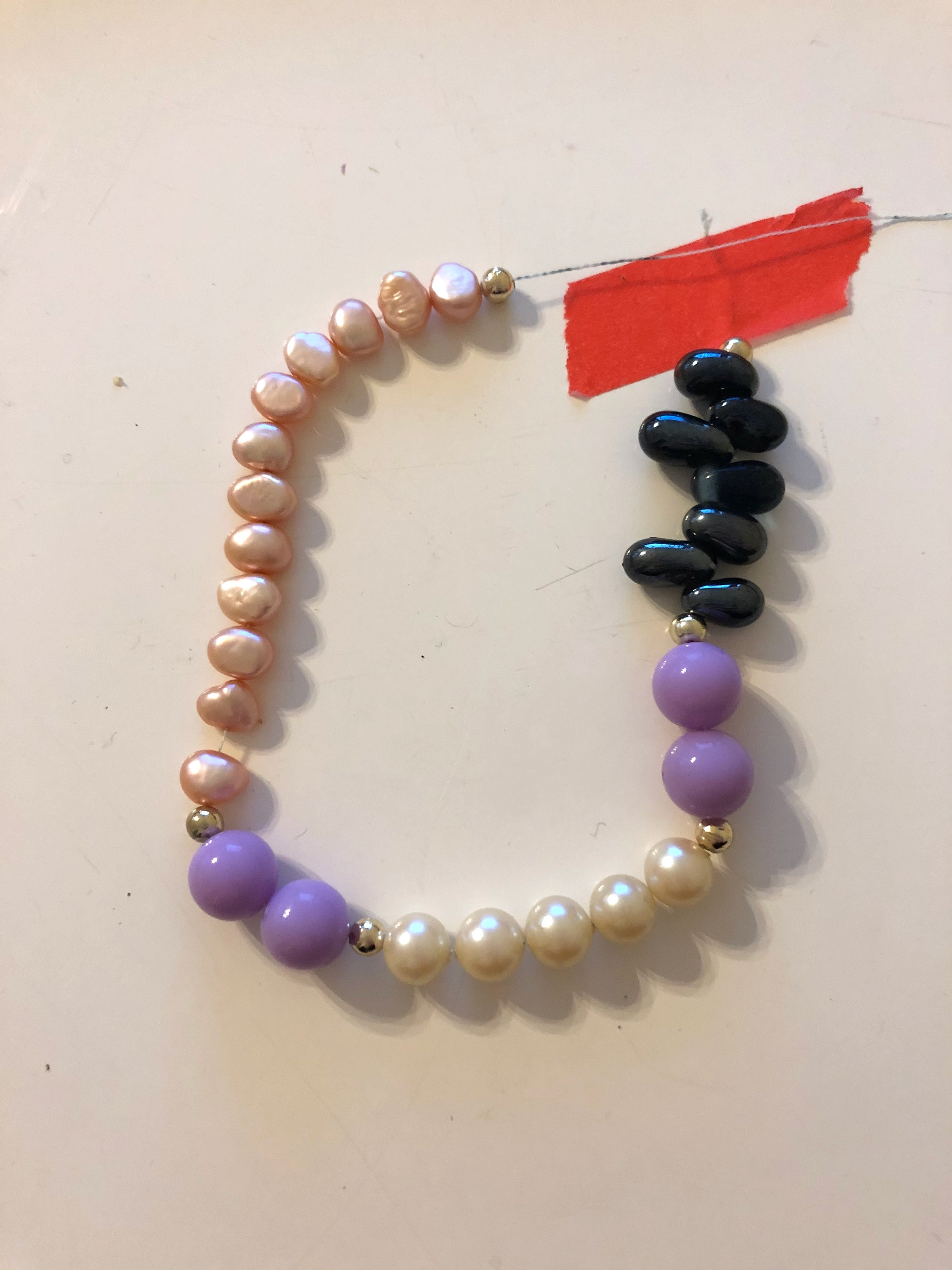
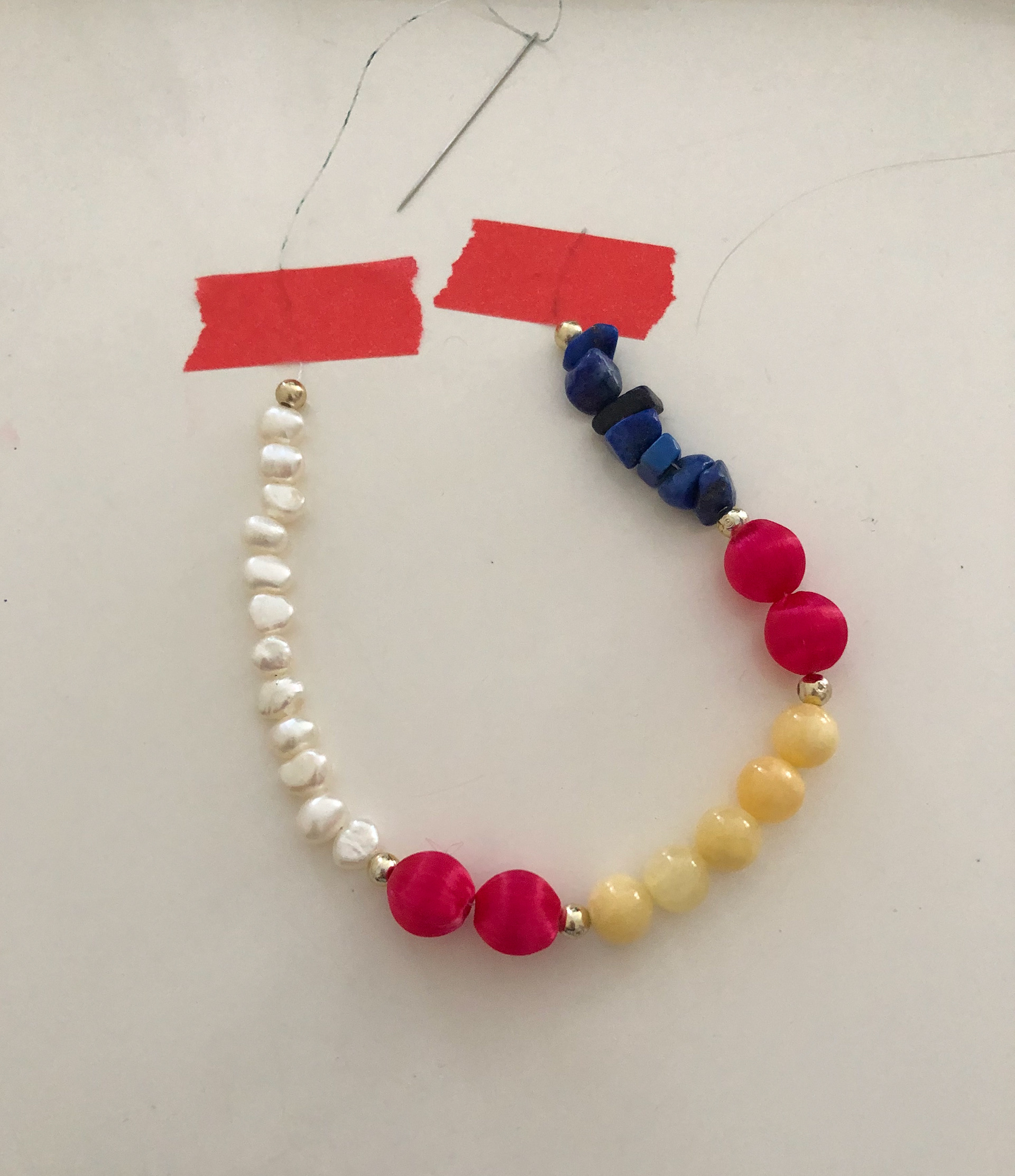
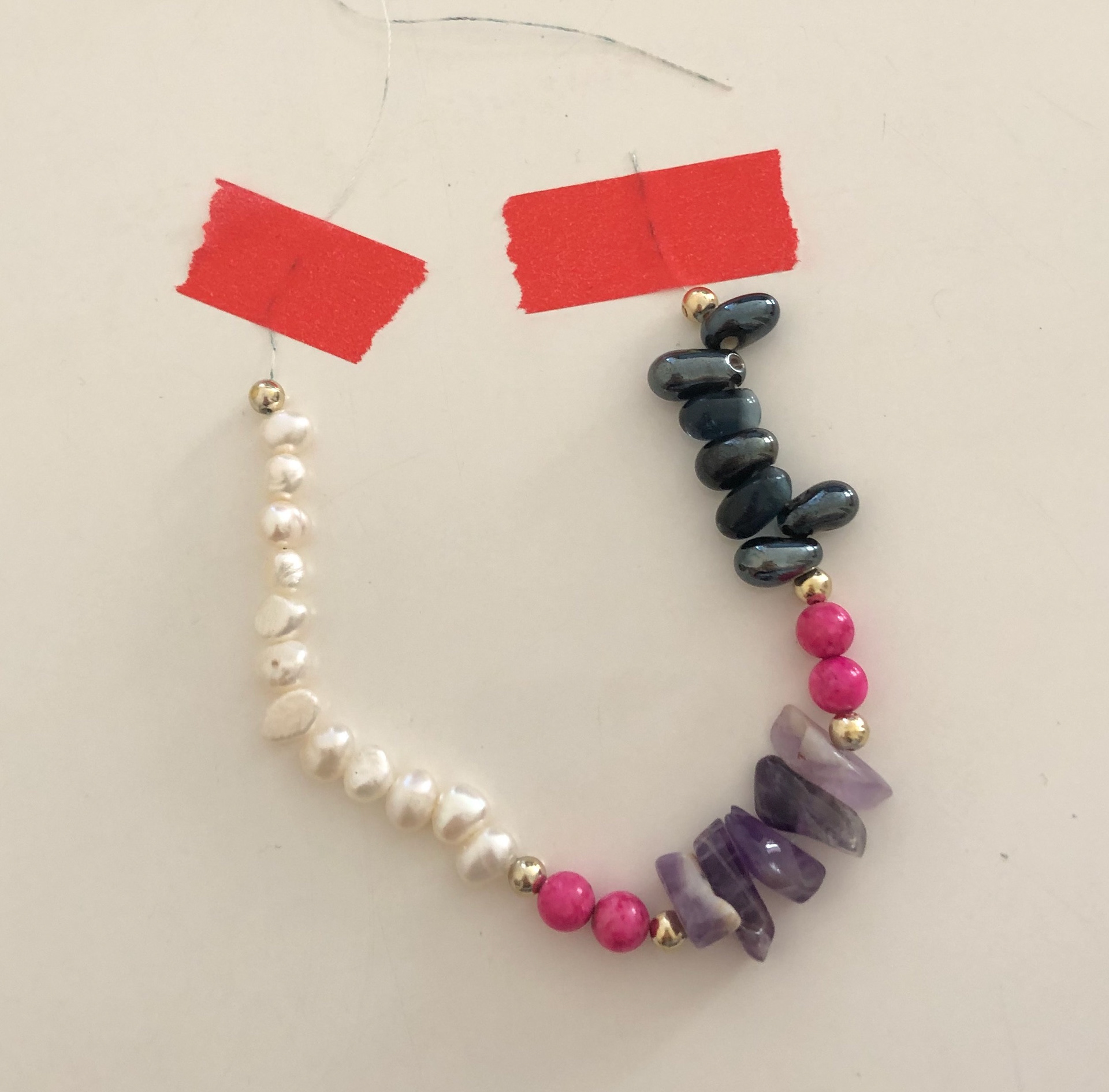
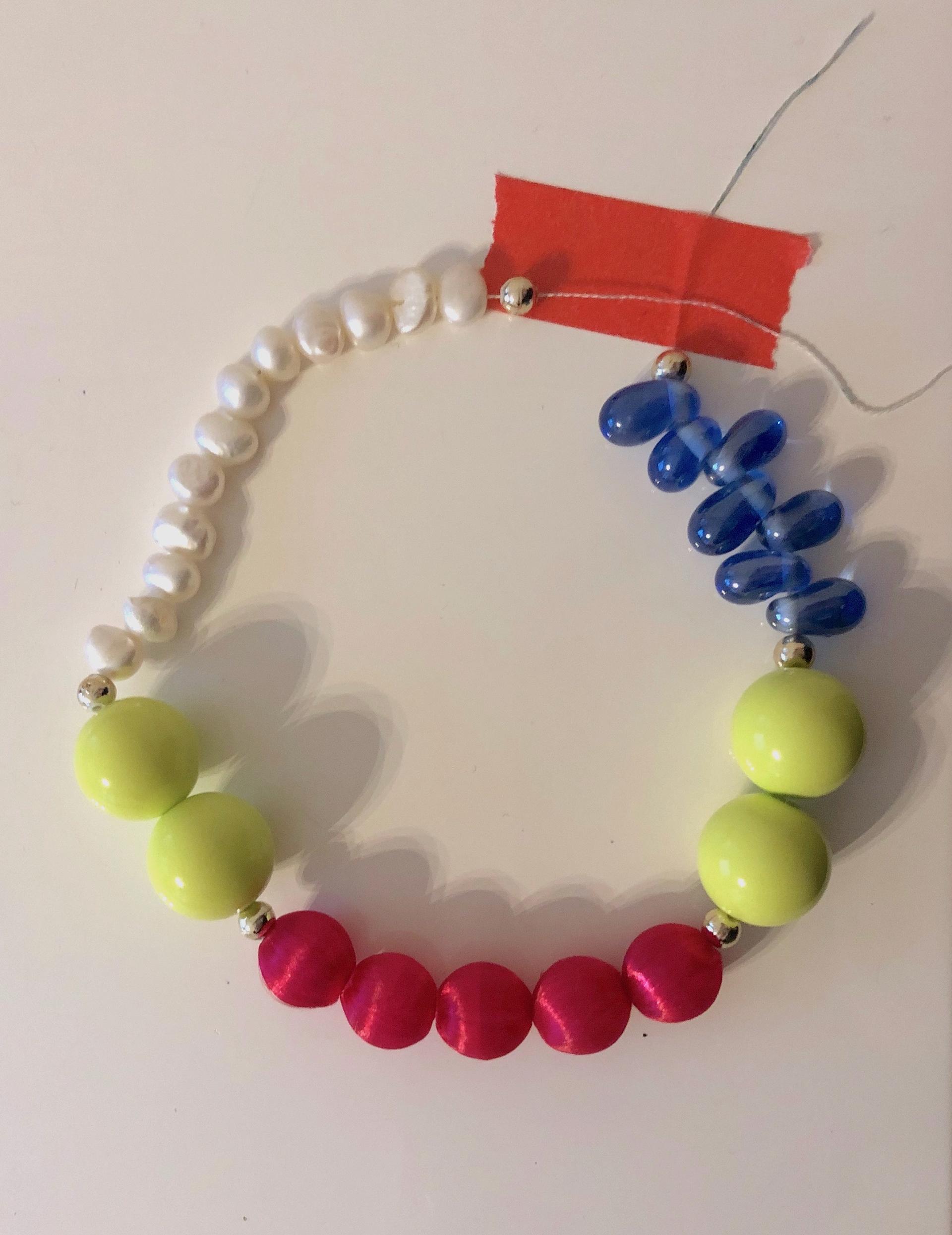
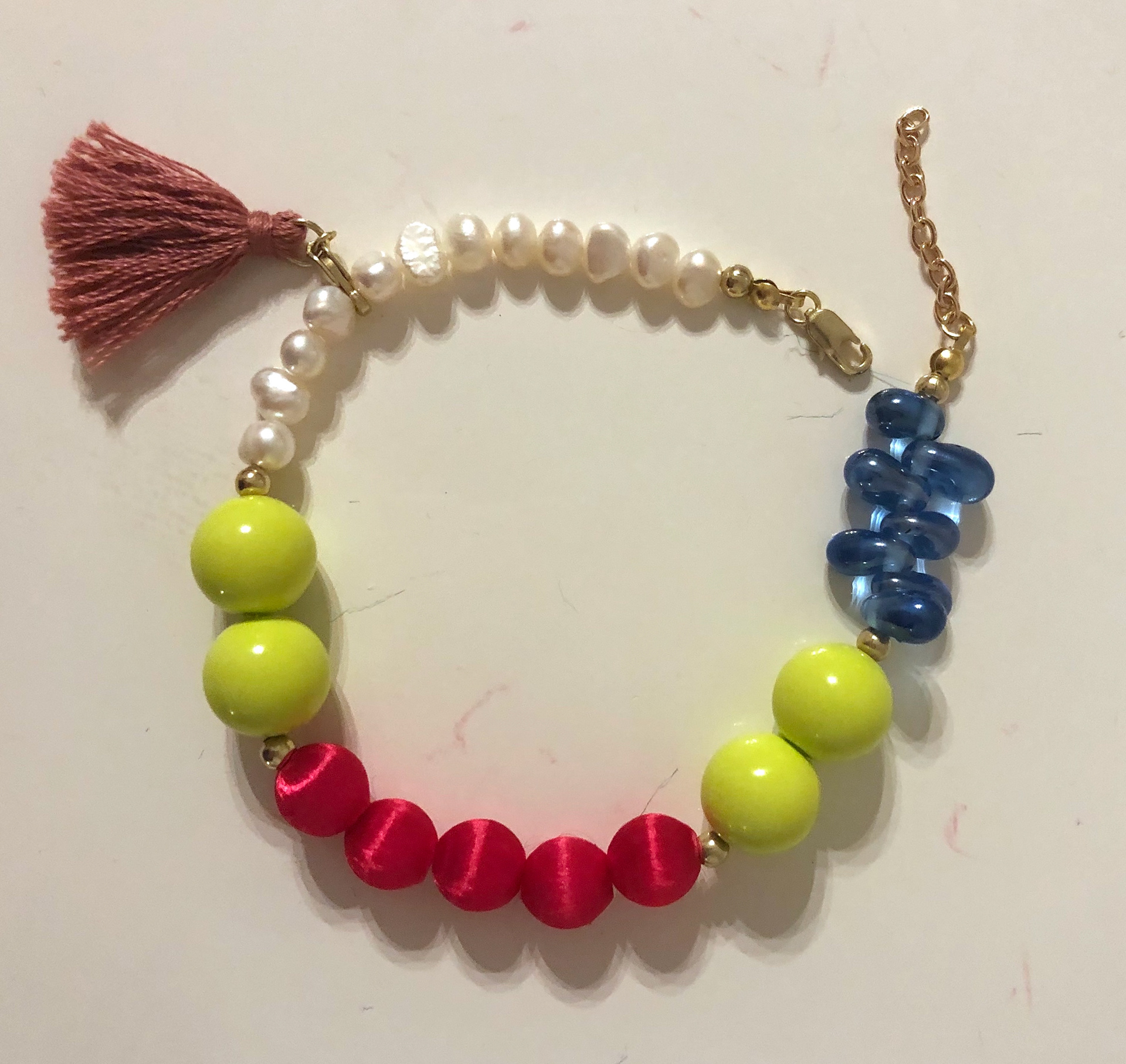
Packaging Ideation
I wanted to utilize the packaging as a guide for how to use the product. The packaging needed to:
1. Describe how to use the product with using as little text as possible
2. Work with varying sizes of jewelry
3. Suggest that it be kept and act as something to hang or display for reference
I designed six symbols to denote each action without text.
To act as a reference while still being slightly discrete, I chose to design the packaging as a wall hanging, similar to a calendar, in a circular form to mimic the menstrual cycle diagram.
I used sketch modeling (below) to determine proper sizing and placement of symbols.
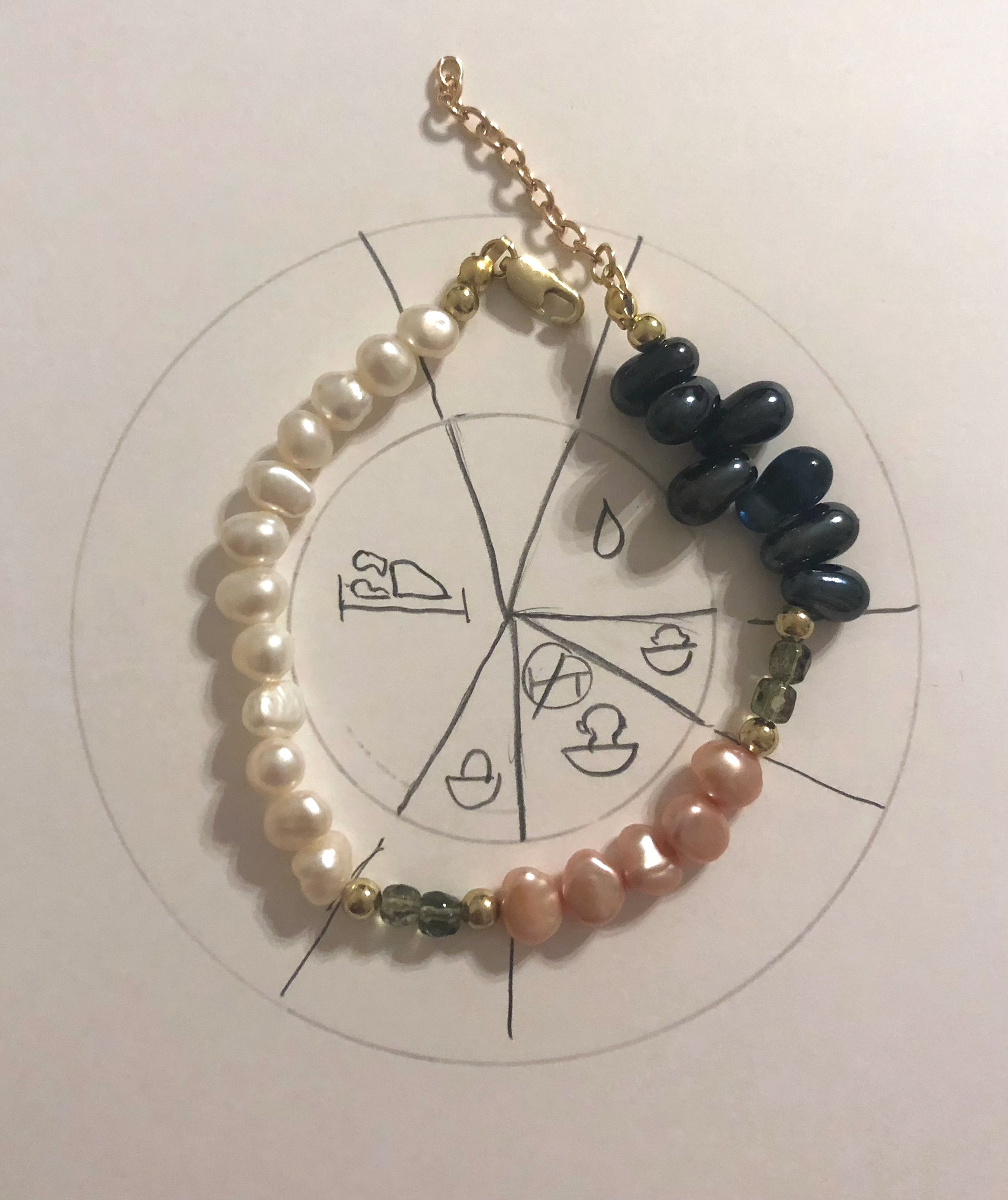
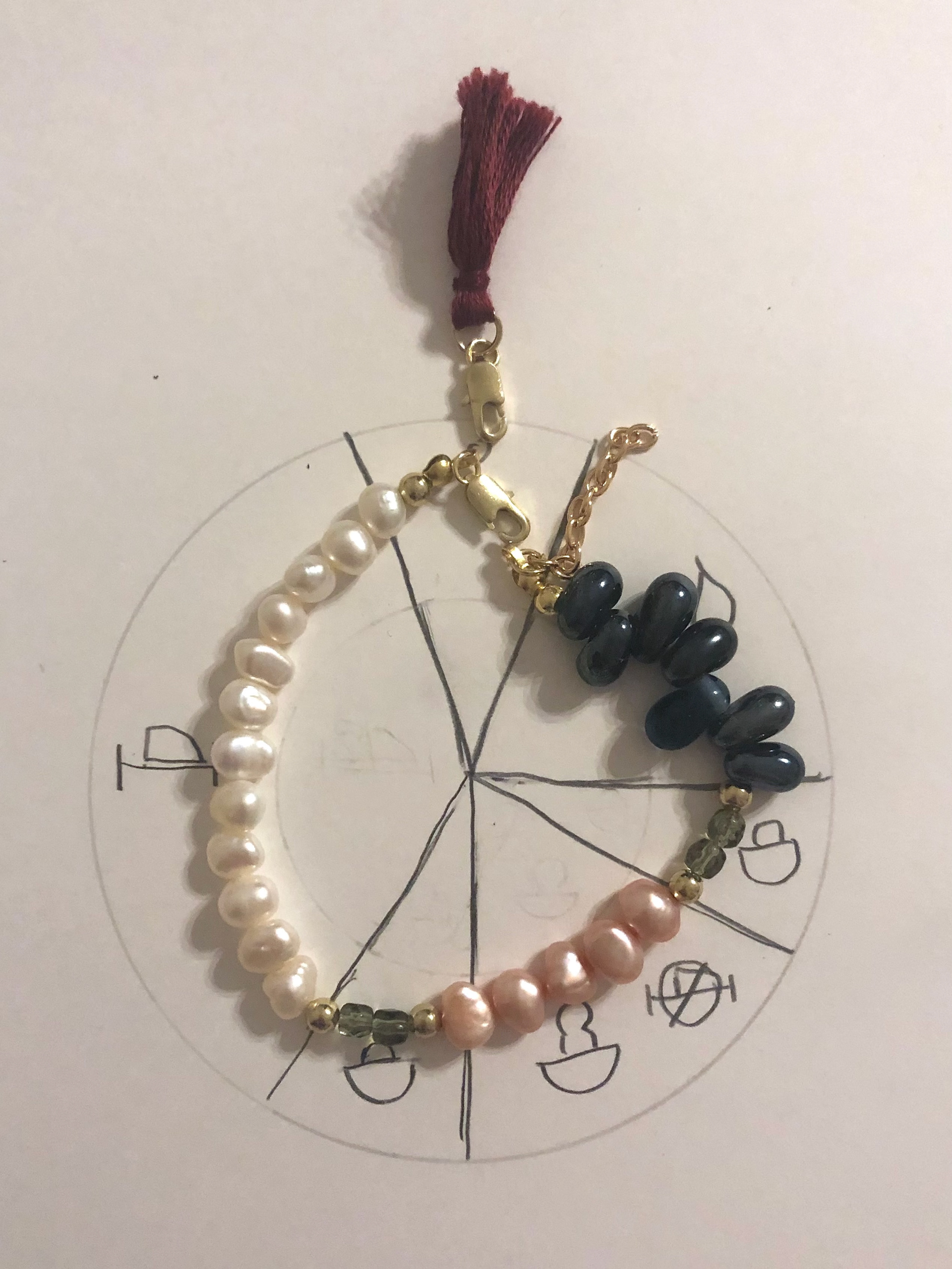
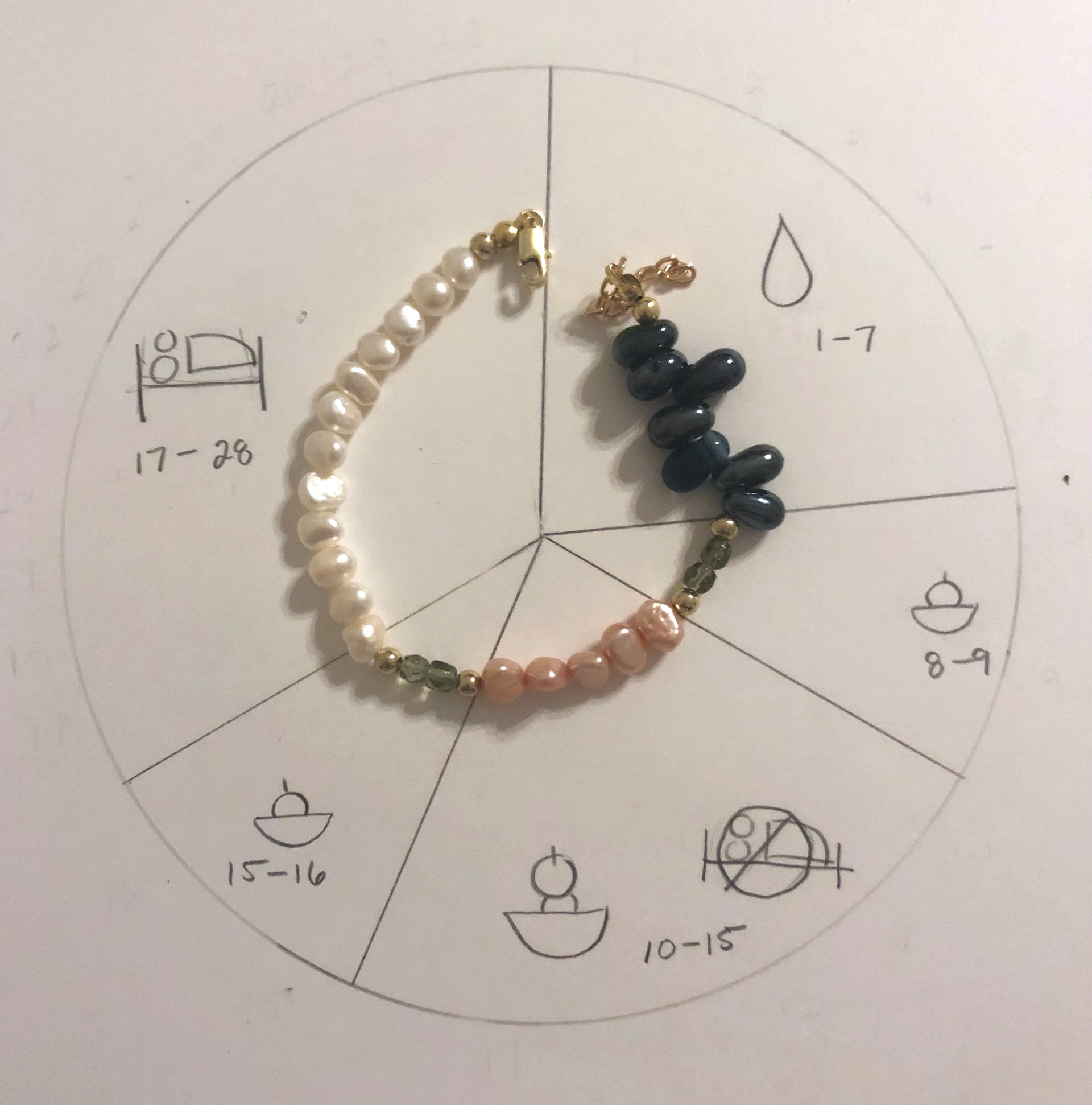
Final Prototype: Almara
How It Works
Each bead within the bracelet or anklet represents a day in the 28 day menstrual cycle.
The user moves the tassel
each day to represent where they are in their cycle.
The different bead types represent phases within the menstrual cycle:
1. Menstruation
2. Follicular phase/Fertile window
3. Ovulatory window
4. End of fertile window
3. Luteal phase4
Icons
To make Almara accessible and easy to understand, icons were used to teach women about their menstrual cycles and provide a schedule to help prevent unwanted pregnancies. The packaging was designed to be repurposed as a reference when hung on a wall.
How to Use
1. Locate the tassel
2. Unhook the tassel
Next Steps
1. Continue to work with Faith and Shalia to ultimately begin user testing in Malawi
2. Revisit detachable charm to design a piece that does not fully detach from the jewelry to prevent misplacing or losing the piece
3. Explore feasibility of using secondhand beads and working with local makers
4. Create a group for girls and women that will accompany Almara to discuss menstruation, sex, and their bodies in a safe space
Sources
1. “A Woman Dies Every Two Minutes due to Pregnancy or Childbirth: UN Agencies.” https://www.who.int/news/item/23-02-2023-a-woman-dies-every-two-minutes-due-to-pregnancy-or-childbirth--un-agencies.
2. “Maternal Mortality.” https://www.who.int/news-room/fact-sheets/detail/maternal-mortality.
3. “Prevent Adolescent Pregnancies, Invest in Comprehensive Sexual Education | UNICEF Zimbabwe.” https://www.unicef.org/zimbabwe/prevent-adolescent-pregnancies-invest-comprehensive-sexual-education.
4. “Physiology of the Female Reproductive System | Boundless Anatomy and Physiology.” https://courses.lumenlearning.com/boundless-ap/chapter/physiology-of-the-female-reproductive-system/.
5. Maternal mortality rates and statistics. UNICEF DATA. https://data.unicef.org/topic/maternal-health/maternal-mortality/
6. Mekonnen T, Dune T, Perz J. Maternal health service utilisation of adolescent women in sub-Saharan Africa: a systematic scoping review. BMC Pregnancy Childbirth. 2019;19:366. doi:10.1186/s12884-019-2501-6
7. The key to improving women’s health in developing countries. AXA.com. https://www.axa.com/en/news/the-key-to-improving-women-s-health-in-developing-countries
8. Maternal mortality. https://www.who.int/news-room/fact-sheets/detail/maternal-mortality
9. Batist J. An intersectional analysis of maternal mortality in Sub-Saharan Africa: a human rights issue. Journal of Global Health. 2019;9(1):010320. doi:10.7189/jogh.09.010320
10. Say L, Chou D, Gemmill A, et al. Global causes of maternal death: a WHO systematic analysis. The Lancet Global Health. 2014;2(6):e323-e333. doi:10.1016/S2214-109X(14)70227-X
11. Maternal death and pregnancy-related death. https://www.marchofdimes.org/find-support/topics/miscarriage-loss-grief/maternal-death-and-pregnancy-related-death
12. Martínez E. Leave No Girl Behind in Africa. Human Rights Watch. Published online June 14, 2018. https://www.hrw.org/report/2018/06/14/leave-no-girl-behind-africa/discrimination-education-against-pregnant-girls-and
13. Duby Z, McClinton Appollis T, Jonas K, et al. “As a Young Pregnant Girl… The Challenges You Face”: Exploring the Intersection Between Mental Health and Sexual and Reproductive Health Amongst Adolescent Girls and Young Women in South Africa. AIDS Behav. 2021;25(2):344-353. doi:10.1007/s10461-020-02974-3
14. Gunawardena N, Fantaye AW, Yaya S. Predictors of pregnancy among young people in sub-Saharan Africa: a systematic review and narrative synthesis. BMJ Glob Health. 2019;4(3):e001499. doi:10.1136/bmjgh-2019-001499
15. To Change Africa’s Path, We Need to Support Rural Girls from Day One. Center For Global Development. https://www.cgdev.org/blog/change-africas-path-we-need-support-rural-girls-day-one
16. Fertility NRC (US) WG on the SD of A, Bledsoe CH, Cohen B. Introduction. In: Social Dynamics of Adolescent Fertility in Sub-Saharan Africa. National Academies Press (US); 1993. https://www.ncbi.nlm.nih.gov/books/NBK236798/
17. Africa: Make Girls’ Access to Education a Reality | Human Rights Watch. June 16, 2017. https://www.hrw.org/news/2017/06/16/africa-make-girls-access-education-reality
18. Teen Pregnancy in Sub-Saharan Africa: The Application of Social Disorganisation Theory | https://www.researchgate.net/publication/304659428_Teen_Pregnancy_in_Sub-Saharan_Africa_The_Application_of_Social_Disorganisation_Theory
19. Ectopic Pregnancy. https://www.acog.org/womens-health/faqs/ectopic-pregnancy
20. Adolescent pregnancy. https://www.who.int/news-room/fact-sheets/detail/adolescent-pregnancy
21. Abortion Care. https://www.acog.org/womens-health/faqs/induced-abortion
22. Abortion and Unintended Pregnancy in Kenya. Guttmacher Institute. (No.2). https://www.guttmacher.org/sites/default/files/report_pdf/ib_unsafeabortionkenya.pdf
23. Lathrop E, Jamieson DJ, Danel I. HIV and maternal mortality. Int J Gynaecol Obstet. 2014;127(2):213-215. doi:10.1016/j.ijgo.2014.05.024
24. Gestational Hypertension. https://www.stanfordchildrens.org/en/topic/default?id=gestational-hypertension-90-P02484
25. Khaskheli MN, Baloch S, Sheeba A. Risk factors and complications of puerperal sepsis at a tertiary healthcare centre. Pak J Med Sci. 2013;29(4):972-976.
26. Hallett V. Millions Of Women Take A Long Walk With A 40-Pound Water Can. NPR. https://www.npr.org/sections/goatsandsoda/2016/07/07/484793736/millions-of-women-take-a-long-walk-with-a-40-pound-water-can. July 7, 2016.
27. UNICEF: Collecting water is often a colossal waste of time for women and girls. https://www.unicef.org/press-releases/unicef-collecting-water-often-colossal-waste-time-women-and-girls
